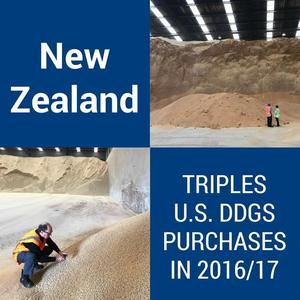USGC: New Zealand triples US DDGS purchases

U.S. Grains Council
September 26, 2017
BY U.S. Grains Council
New Zealand’s got milk—record amounts of milk production—and the country’s dairy industry is feeding triple the amount of U.S. distillers dried grains with solubles (DDGS) year-over-year.
The 2017 milk supply in New Zealand is expected to reach 21.9 million tons, surpassing the prior record of 2014, thanks to higher-expected cow numbers and optimal pasture conditions. The dairy industry imports approximately 2 million tons palm kernel meal (PKM) to supplement pastures, and only 5 percent of the total dairy industry is currently utilizing DDGS or soybean hall pellets (SBHP) in rations.
However, the door is open for increased use of DDGS following local crop failures due to excessive rains compounded by an industry push to limit the ration of PKM due to negative effects on butter fat levels. As a result, grain buyers significantly increased purchases with two combination vessels discharging U.S. DDGS in the port of Tauranga in September 2017.
New Zealand has purchased 113,000 metric tons of U.S. DDGS in the 2016-‘17 marketing year (September-July), up significantly from the 37,000 tons imported the same time the year prior. While this market is currently small, these sales represent the potential for demand growth.
“This record production is translating into higher U.S. DDGS demand for the New Zealand dairy sector,” said Manuel Sanchez, the U.S. Grains Council's South & Southeast Asia regional director. “We expect to see strong demand for U.S. DDGS into this market in coming years as the dairy industry incorporates more co-products into their feeding programs.
Advertisement
Advertisement
Advertisement
Advertisement
Related Stories
CoBank’s latest quarterly research report, released July 10, highlights current uncertainty around the implementation of three biofuel policies, RFS RVOs, small refinery exemptions (SREs) and the 45Z clean fuels production tax credit.
The U.S. Energy Information Administration maintained its forecast for 2025 and 2026 biodiesel, renewable diesel and sustainable aviation fuel (SAF) production in its latest Short-Term Energy Outlook, released July 8.
XCF Global Inc. on July 10 shared its strategic plan to invest close to $1 billion in developing a network of SAF production facilities, expanding its U.S. footprint, and advancing its international growth strategy.
U.S. fuel ethanol capacity fell slightly in April, while biodiesel and renewable diesel capacity held steady, according to data released by the U.S. EIA on June 30. Feedstock consumption was down when compared to the previous month.
XCF Global Inc. on July 8 provided a production update on its flagship New Rise Reno facility, underscoring that the plant has successfully produced SAF, renewable diesel, and renewable naphtha during its initial ramp-up.
Upcoming Events










